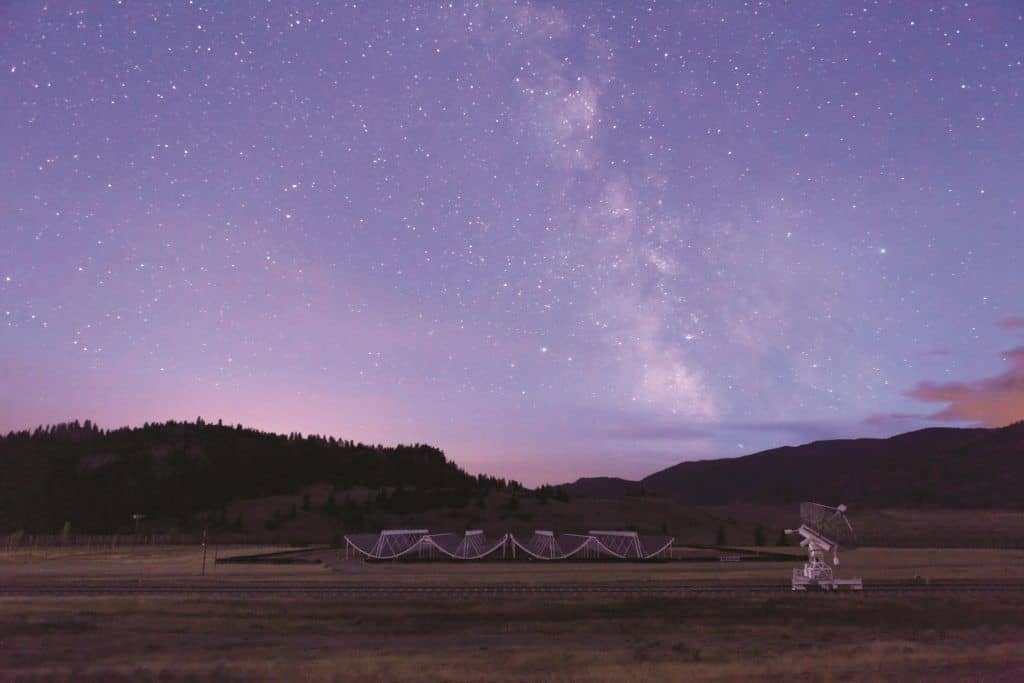Astronomical events, like the birth of a star or formation of a galaxy, typically take place on vast time scales: millions or even billions of years. But some can occur in a relative blink of an eye.
These “transients” come in many forms, from supernovae to planetary transits, and can occur over years, weeks, days, or even milliseconds. In the past 10 years, astronomers have identified a mysterious new population of transients: brief, bright, and rare flickers known as fast radio bursts (FRBs).
Now, a group of Canadian researchers has proposed a way to hunt for these rare flickers using a new telescope. When they turn it on, they expect to see not just one or two FRBs, but hundreds.
In 2007, astronomers noticed a spectacularly bright but incredibly short signal in archival data collected by the Parkes Observatory, a radio telescope in New South Wales, Australia. The whole event lasted less than five milliseconds. Blink and you’ll miss it? Actually, blink and you would miss up to 40 FRBs; the average human blink lasts about 200 milliseconds.
Their fleeting nature means they are also rarely seen. In the decade since that first discovery, only 25 more bursts have been observed.
With so few recorded events, there are more theories about the origin and nature of FRBs than there are detections. Part of the problem is simply the lack of data. It is incredibly difficult to pin down exactly where in the universe the bursts are coming from.
'A game-changing experiment'
CHIME, which stands for Canadian Hydrogen Intensity Mapping Experiment, is an innovative new radio telescope under construction near Penticton, British Columbia, that could solve the mystery of the FRBs when it comes online later this year.
The telescope is expected to see almost as many bursts in the first few days of its operation as have been detected in the past 10 years. “In two and a half days, we’ll have found more FRBs than the rest of the world,” says Perimeter Faculty member Kendrick Smith. “It’s going to be a game-changing experiment.”
The full project is a collaboration between researchers at the University of Toronto, the University of British Columbia, McGill University, and the Dominion Radio Astrophysical Observatory. Several Perimeter researchers, including Smith, are lending their theoretical expertise to the project.
The search for ultrafast blips is actually something of a bonus mission: CHIME’s primary task is to probe a lesser-studied stretch of time in the universe’s history known as the “adolescent universe,” which lies between the aftermath of the big bang (now considered well-understood, thanks to high-precision measurements of the cosmic microwave background radiation) and the more recent universe that can be studied via conventional telescopes.
To do this, CHIME will measure how neutral hydrogen clumps together in distant galaxies. The hydrogen acts as a tracer of density and large-scale structure in the universe. By understanding how the universe grew in its teenager phase, the CHIME team hopes to gain insight into one of the most puzzling problems in cosmology: the nature of “dark energy,” the mysterious force responsible for the acceleration of the universe’s expansion.
At a Canadian Institute for Advanced Research meeting in 2014 – which brought together theorists, experimentalists, and observational astronomers from a number of different subfields, including transient astronomy – researchers realized CHIME’s exceptional capabilities could be broadened with relatively little effort.
Radio transient expert Victoria Kaspi, a physics professor and Director of the McGill Space Institute, pitched a proposal to the Canada Foundation for Innovation to add an additional computing cluster to CHIME’s antennas dedicated to combing the data for elusive FRB signals. "The FRB problem is one of the most interesting new puzzles in astrophysics today," says Kaspi. "It was great luck that CHIME was being built just at the time this puzzle really emerged."
'An avalanche of data'
The setup is ideal because CHIME can survey the sky faster than any other radio telescope on the planet. Think of a digital camera: the more pixels there are in the sensor, the higher the resolution of the photograph. Radio telescopes have far fewer “pixels,” because the wavelengths they are detecting are huge compared to visible light, but the principle is the same: the more pixels you have, the greater detail you can see in a given time.
“Currently, the biggest coherent receiver on any radio telescope is the Parkes Observatory, which has a 13-pixel receiver,” explains Ue-Li Pen, a Perimeter Associate Faculty member and Interim Director of the Canadian Institute for Theoretical Astrophysics.
“Almost all other radio telescopes have one pixel. In comparison, CHIME has a thousand pixels. So whatever Parkes can do, CHIME is going to do another factor of 100 times better and faster.”
The increase in sensitivity brings with it another set of challenges, says Smith. “We’re going to generate an avalanche of data.”
CHIME will churn out a petabyte of data every single day. That’s 1,024 terabytes, or a million gigabytes – equivalent to more than 38 years of continuously binge-watching Netflix in HD, or more than 990 years of streaming high-quality music.
The CHIME team has to search that data as it arrives, in real time. “It’s too much to save to disk, so you only get to look at it during a little window of time when it’s in memory,” explains Smith. “You need big supercomputers on site, doing real-time processing for every analysis we want to do – including FRBs.”
The team originally assumed that it would be impossible to process that magnitude of data so quickly. “We thought we would have 10 people working on it. We’d buy this gigantic farm of machines, with a huge power bill, and only search a subset of the data,” says Pen. Then they discovered some promising but little-used algorithms that could help speed up their search.
“Kendrick got excited,” says Pen with a chuckle. “If it’s a nifty algorithm problem, that’s right up his alley.”
The code that Smith, his students Masoud Rafiei-Ravandi and Utkarsh Giri, and research assistant Maya Burhanpurkar, helped develop and optimize is “a hundred times faster than anybody expected,” says Pen. “It’s going to be better than ever thought possible, at a tenth the power cost. This is a case where just the right person going in can change the game.”
As the code sifts through the signals, it also has to contend with potential false positives. “Every time someone uses, say, a keyless entry to a car in the parking lot – that can look like an FRB in our data,” says Smith. “And there are lots of little computers in cars. A car going by on a nearby road can interfere with the data.” To minimize the human-made disruptions, visitors to the CHIME site have to power off their cell phones and turn off the Wi-Fi capabilities on their laptops.
One question CHIME should be able to answer is whether or not fast radio bursts are one-off occurrences – perhaps produced by cataclysmic events like supernovae or the collision of dense objects such as neutron stars or black holes – or if they repeat themselves. Of the 26 FRB detections to date, only one of the bursts has repeated itself, but it’s possible, according to Pen, that all FRBs repeat eventually.
“It’s an open question,” he says, “but CHIME will solve that problem. If they repeat, CHIME will see it.” It will also be able to detect whether the bursts repeat in a predictable, periodic fashion – a result that would line up with one hypothesis suggesting they are somehow associated with neutron stars.
Once CHIME is turned on, Smith expects the telescope will see events almost immediately. “In the optimistic scenario, where all of the software and hardware works smoothly and there are no problems – which never happens – then I think we would see events basically right away, on the first day.”
Further exploration
About PI
Perimeter Institute is the world’s largest research hub devoted to theoretical physics. The independent Institute was founded in 1999 to foster breakthroughs in the fundamental understanding of our universe, from the smallest particles to the entire cosmos. Research at Perimeter is motivated by the understanding that fundamental science advances human knowledge and catalyzes innovation, and that today’s theoretical physics is tomorrow’s technology. Located in the Region of Waterloo, the not-for-profit Institute is a unique public-private endeavour, including the Governments of Ontario and Canada, that enables cutting-edge research, trains the next generation of scientific pioneers, and shares the power of physics through award-winning educational outreach and public engagement.
You might be interested in



Spiralling light from M87’s supermassive black hole reveals strong magnetic fields
November 8, 2023
